Raghu Kumaravelu1*, Ranjitha R2, Sathyanarayanan R3, Venugopalan V4, Sailesh Kumer4, Raja Sethupathy Cheeman4
1Reader, Department of Oral and Maxillofacial Surgery, IGIDS, Sri Balaji Vidhyapeeth, India
2Department of Oral and Maxillofacial Surgery, IGIDS, Sri Balaji Vidhyapeeth, India
3Professor and Head, Department of Oral and Maxillofacial Surgery, IGIDS, Sri Balaji Vidhyapeeth, India
4Senior Lecturer, Department of Oral and Maxillofacial Surgery, IGIDS, Sri Balaji Vidhyapeeth, India
*Corresponding Author: Raghu Kumaravelu, Department of Oral and Maxillofacial Surgery, Indira Gandhi Institute of Dental Sciences, Pillaiyarkuppam, Pondicherry, India; Email: [email protected]
Published Date: 09-11-2022
Copyright© 2022 by Kumaravelu R, et al. All rights reserved. This is an open access article distributed under the terms of the Creative Commons Attribution License, which permits unrestricted use, distribution, and reproduction in any medium, provided the original author and source are credited.
Abstract
Aim: The aim of the study is to assess the effect of virtual reality distraction on pain and anxiety during therapeutic extraction of bilateral maxillary first premolars.
Design: Non Randomized prospective split mouth technique requiring therapeutic extraction of bilateral maxillary first premolars.
Setting: All patients reporting to the department of OMFS Indira Gandhi dental college and hospital Pondicherry requiring therapeutic extraction of bilateral maxillary first premolars.
Participants: Covering 56 patients requiring therapeutic extraction of bilateral maxillary first premolars who meets the inclusive and exclusive criteria.
Main Outcome Measures: Anxiety is measured using Likert scale, vitals using sphygmomanometer and pulse oximeter.
Results: Parameters analysed using T-test, there is subsequent reduction of Systolic blood pressure, respiratory rate and pulse rate using virtual reality distraction when compared to without virtual reality distraction except for diastolic blood pressure.
Conclusion: By distracting the attention of the patient, pain and anxiety levels of the patients can be reduced and producers can be done smoothly according to our study results.
Keywords
Virtual Reality; Bilateral Maxillary; Diastolic Blood Pressure; Systolic Blood Pressure
Introduction
Pain and anxiety management plays a vital role in achieving a favourable outcome in any dental procedure [1]. Majority of patients fail to look after the dental procedures fearing the trauma and pain associated with it. Various studies have suggested that about 5%-20% of adult population suffer dental anxiety which is caused by conditioning through traumatic or painful experiences [2]. Studies suggest that anticipated dental pain among patients is usually less than the actual pain experienced post procedure [3,4]. Studies have also suggested that dental pain making it mandatory to address the issues related to pain and anxiety [2,5]. Pain sensation is associated with psychological components which are achieved by conscious attention. In an attempt to manage the pain sensation various distraction devices has been employed to distract the patient from conscious attention [6].
The mainstream management of pain is carried out with the help of analgesics [7]. Analgesics along with behaviour management play a vital role in pain and anxiety management [8]. Attention distract technique during procedure can distract patient from conscious attention towards pain sensation. Virtual Reality (VR) distraction is believed to be a promising pain distraction strategy for reducing the level of discomfort associated with extractions. VR reduces pain by allowing the user to be engaged and immersed in a computer-generated environment [10,12]. Virtual reality may also appeal to patients’ innate urge to “escape” from pain. Considering extraction as one of the most painful procedures, distracting the patient from conscious attention towards pain is of prime importance. Thus in this study we aim at assessing the effect of virtual reality distraction on pain perception, anxiety and hemodynamic changes during therapeutic extraction of bilateral maxillary first premolars.
Materials and Methods
This study was conducted following the approval from the Institutional Ethical Committee, Indira Gandhi institute of dental science committee no ECR/290/Indt/PY/2018, Approval code no: IGIDSIEC2019NRP06FARAOMS. A voluntary written consent was obtained from all the study participants. The study involved a non-randomised prospective split mouth technique covering 56 participants who required bilateral therapeutic extraction of maxillary first premolars.
Inclusion Criteria
- Patients indicated for bilateral maxillary premolar therapeutic extraction for their orthodontic treatment
- Patients within the age group of 13-25
Exclusion Criteria
- Patient not willing for study
- Patient with vision problems
- Medically compromised individuals
- Pregnant women
- Patients with motion sickness
Controlled sampling technique was followed. All the patients were asked to mark their anxiety level on the Likert scale preoperatively (A1). Vitals namely Systolic Blood Pressure (SBP 1), Diastolic Blood Pressure (DBP 1), Pulse rate (PP1), Respiratory Rate (RR 1) and Oxygen saturation (Sp O1) were recorded preoperatively using a formatted word document. The quadrant in which the study was conducted (i.e. the quadrant in which extraction was done along with virtual reality distraction) was changed alternatively for each patient.
Local anaesthesia was administered. After the extraction of first tooth (without the use of virtual reality distraction), patients were asked to mark their anxiety level (A2) and pain perception (P1) on Likert scale and Visual analogue scale respectively. The patients were exposed to virtual reality distraction using head-mounted immersive type of display powered by a smartphone and VR box virtual reality glasses (Fig. 1). Relaxing and calming video of a garden is played for about 10 minutes (Fig. 2). Then the patients were asked to mark their anxiety level on the Likert scale (A3) and the vitals – Systolic Blood Pressure (SBP 2), Diastolic Blood Pressure (DBP 2) (Fig. 3).
Pulse rate (PP2), Respiratory Rate (RR 2) and Oxygen Saturation (Sp O2) were recorded (Fig. 4). Local anaesthesia was administered in the other quadrant and the virtual reality distraction was used till the end of the procedure (Fig. 5). Lastly the patients were asked to mark their anxiety level (A4) and pain perception (P2) on Likert scale and Visual analogue scale respectively (Fig. 4-6).
Patient and Public Involvement
During the study design process, we made a Performa which was ease to the patient knowledge and give there valuable remarks in it, Patients who reported to the department who required bilateral maxillary first premolar extraction after assessing the inclusive and exclusive criteria were taken up after complete explanation of the study. Once the study results are finalized the outcome of the study will be explained to each and every patient who is involved in the study for the betterment and wellness in the future.
Result
The collected data of all the parameters were analysed using t test and the value of <0.05 was considered significant.
The mean age of the patients were found to be 13-25. Statistical analysis of the values of pain perception and anxiety revealed that the pain perception and anxiety in patients undergoing extraction without virtual reality distraction was 4.84 ± 0.739 and 4.53 ± 0.504 respectively and in patients undergoing extraction along with virtual reality distraction was 1.47 ± 0.504 and 1.35 ± 0.480 respectively. A highly significant reduction in pain perception and anxiety is reported in patients undergoing extraction with virtual reality distraction by significant P value of 0.000 (Table 1).
N | Mean | Std. Deviation | t | df | p-value | ||
Pain | P 1 | 56 | 4.84 | 0.739 | 28.044 | 54 | 0 |
P 2 | 56 | 1.35 | 0.504 | ||||
Anxiety | A1 | 56 | 4.53 | 0.504 | 36.818 | 54 | 0 |
A3 | 56 | 1.35 | 0.48 | ||||
Systolic blood pressure | SBP 1 | 56 | 122.91 | 4.58 | 1.922 | 54 | 0.06 |
SBP 2 | 56 | 121.27 | 3.36 | ||||
Diastolic blood pressure | DBP 1 | 56 | 80 | 0 | – | 54 | – |
DBP 2 | 56 | 80 | 0 | ||||
Pulse rate | PR 1 | 56 | 82.27 | 0.651 | 8.365 | 54 | 0 |
PR 2 | 56 | 80.87 | 1.001 | ||||
Respiratory rate | RR 1 | 56 | 20.67 | 0.963 | 4.137 | 54 | 0 |
RR 2 | 56 | 20.13 | 0.388 | ||||
Oxygen saturation | SpO 1 | 56 | 99.62 | 0.49 | -2.104 | 54 | 0.04 |
SpO 2 | 56 | 99.8 | 0.404 |
Table 1: Comparison of mean values of parameters before and after use of virtual reality distraction.
Though not significant, very mild reduction in Systolic blood pressure, respiratory rate and pulse rate is noted in patients after using virtual reality distraction. Statistical analysis of pulse rate values revealed that the pulse rate in patients undergoing extraction without using virtual reality distraction was 82.27± 0.651 and in patients undergoing extraction along with using virtual reality distraction was 80.87 ± 1.001.
No change in Diastolic blood pressure was observed with and without virtual reality distraction (Fig. 6).
Discussion
The current study was focussed on conducting a research that involved distraction devices to reduce pain sensation and anxiety during the dental procedures. The distraction of pain attained from conscious attention can be reduced by various distraction devices. One of those devices which were given the prime importance is the virtual reality devices that calm the patients helping the patient to distract from the pain causing procedures. Hunter Hoffman in his study highlighted the capability of VR as a multidisciplinary tool that aids in attention-grabbing. The study also revealed the logic behind VR. The study stated that human attention is a finite, flexible, and sharable processing resource. Performing a task demands attention and pain uses the same attentional resources, and thus reducing the amount of attention will in turn reduce the pain perception [13]. Aasiya Ougradar in his study highlighted that VR works as a principal method in reducing anxiety [14]. The study also reported difference in experiences among male and female patients. Females gave their VR experience a lower rating than males, according to one survey. Some females reported feeling uneasy, claustrophobic, and unaware of their surroundings when using virtual reality. Studies have shown that a virtual reality presentation can alleviate discomfort during burn treatment, as well [15].
VR was tested on individuals with complicated regional pain syndrome by Sato, et al., who saw a 50% reduction in pain intensity. In agreement with a reduction of the pain intensity ratings similar results was seen in our study where the patients presented with reduction in post-operative pain perception [16]. Kumar Raghav Gujjar, et al., suggested that the favourable effects of virtual reality exposure therapy may be attributable in part to the patient’s strong sense of presence and realistic VR experience during treatment [17].
Thus in the present study the patients were distracted by the use of a distraction strategy. In order to alleviate the patient’s agony, this strategy is the most effective at diverting their attention.
Conclusion
Diversion or distracting our mind from concentrating to a particular point will sure gives us lot of changes, the same when applied in extraction the results were positive. When our mind is totally diverted away from the dental procedure the anxiety level and hemodynamic changes can be clearly appreciated. In patients point of view there is a good improvement in their comfort level during extraction procedure with virtual reality mind diversions.
Limitations of the Study
The study included 56 participants. Increasing the number of sample will aid in interpretation of results with significant values and for deriving the better treatment protocols.
Future Prospects
The virtual reality distraction technique when incorporated for other minor maxillofacial procedures performed under local anaesthesia.
Contributor-ship Statements
Author 1 and 2 presented the study in IEC and completed the study doing all cases. Author 3 is the guide for the study author 4 aided in researches in writing the article.
Conflict of Interest
The authors declare non-financial conflict of interest.
References
- Asl Aminabadi N, Erfanparast L, Sohrabi A, Ghertasi Oskouei S, Naghili A. The impact of virtual reality distraction on pain and anxiety during dental treatment in 4-6 year-old children: a randomized controlled clinical trial. J Dent Res Dent Clin Dent Prospects. 2012;6(4):117-24.
- Maggirias J, Locker D. Psychological factors and perceptions of pain associated with dental treatment. Community Dent Oral Epidemiol. 2002;30(2):151-9.
- Kent G. Memory of dental pain. Pain. 1985;21(2):187-94.
- Lindsay SJE, Wege P, Yates J. Expectations of sensations, discomfort and fear in dental treatment. Behav Res Ther. 1984;22(2):99-108.
- Lindsay S, Jackson C. Fear of routine dental treatment in adults: Its nature and management. Psychol Health. 1993;8(2-3):135-53.
- Aminabadi NA, Farahani RMZ, Balayi Gajan E. The efficacy of distraction and counterstimulation in the reduction of pain reaction to intraoral injection by pediatric patients. J Contemp Dent Pract. 2008;9(6):33-40.
- Wiederhold MD, Gao K, Wiederhold BK. Clinical use of virtual reality distraction system to reduce anxiety and pain in dental procedures. Cyberpsychology, Behav Soc Netw. 2014;17(6):359-65.
- Becker DE. Pain management: Part 1: Managing acute and postoperative dental pain. Anesth. Prog. 2010;57(2):67-78.
- Solete P. Comparative evaluation of various analgesics in irreversible pulpitis to reduce pain. Bioinformation. 2021;17(2):313-9.
- Cheruvatoor JJ, Kaini L, Hanafiah MABMA, Sihabubdin MA Bin, Marla V. Use of Virtual Reality (VR) as an audio-visual distraction tool in the reduction of dental anxiety during local anesthesia. J Pharm Res Int. 2021;33:102-8.
- Gazal G, Al-Samadani KH. Comparison of paracetamol, ibuprofen, and diclofenac potassium for pain relief following dental extractions and deep cavity preparations. Saudi Med J. 2017;38(3):284-91.
- Atzori B, Grotto RL, Giugni A, Calabrò M, Alhalabi W, Hoffman HG. Virtual reality analgesia for pediatric dental patients. Front Psychol. 2018;9:1-6.
- Tool N. Reality : a new tool for interdisciplinary. Psychol Gy. 1998;1(2):195-200.
- Ougradar A, Ahmed B. Patients’ perceptions of the benefits of virtual reality during dental extractions. Br Dent J. 2019;227(9):813-6.
- Hoffman HG, Doctor JN, Patterson DR, Carrougher GJ, Furness TA. Virtual reality as an adjunctive pain control during burn wound care in adolescent patients. Pain. 2000;85(1-2):305-9.
- Sato K, Fukumori S, Matsusaki T, Maruo T, Ishikawa S, Nishie H, et al. Nonimmersive virtual reality mirror visual feedback therapy and its application for the treatment of complex regional pain syndrome: An open-label pilot study. Pain Med. 2010;11(4):622-9.
- Gujjar KR, Van Wijk A, Kumar R, De Jongh A. Efficacy of virtual reality exposure therapy for the treatment of dental phobia in adults: A randomized controlled trial. J Anxiety Disord. 2019;62(2018):100-8.
Article Type
Research Article
Publication History
Received Date: 12-10-2022
Accepted Date: 02-11-2022
Published Date: 09-11-2022
Copyright© 2022 by Kumaravelu R, et al. All rights reserved. This is an open access article distributed under the terms of the Creative Commons Attribution License, which permits unrestricted use, distribution, and reproduction in any medium, provided the original author and source are credited.
Citation: Kumaravelu R, et al. Effect of Virtual Reality Distraction on Pain Perception, Anxiety and Hemodynamic Changes during Therapeutic Extraction of Bilateral Maxillary First Premolars Split-Mouth Technique. J Dental Health Oral Res. 2022;3(3):1-10.
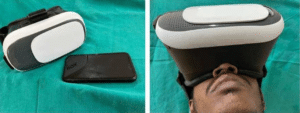
Figure 1: Virtual Reality glasses with smart phone and head mounted.

Figure 2: Video of garden showed in virtual reality.
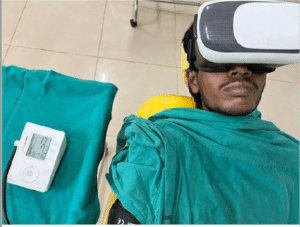
Figure 3: Recording pulse pressure under virtual reality.
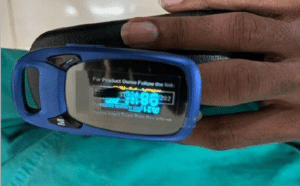
Figure 4: Recording vitals using pulse oximeter.
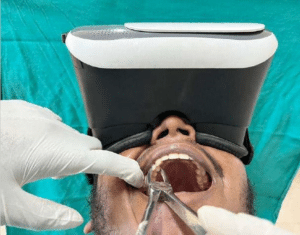
Figure 5: Virtual reality distraction till the end of the producer.
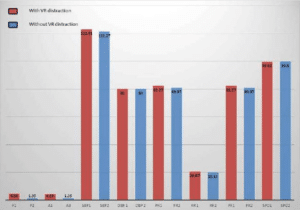
Figure 6: Showing the difference in parameter in both the quadrants.
N | Mean | Std. Deviation | t | df | p-value | ||
Pain | P 1 | 56 | 4.84 | 0.739 | 28.044 | 54 | 0 |
P 2 | 56 | 1.35 | 0.504 | ||||
Anxiety | A1 | 56 | 4.53 | 0.504 | 36.818 | 54 | 0 |
A3 | 56 | 1.35 | 0.48 | ||||
Systolic blood pressure | SBP 1 | 56 | 122.91 | 4.58 | 1.922 | 54 | 0.06 |
SBP 2 | 56 | 121.27 | 3.36 | ||||
Diastolic blood pressure | DBP 1 | 56 | 80 | 0 | – | 54 | – |
DBP 2 | 56 | 80 | 0 | ||||
Pulse rate | PR 1 | 56 | 82.27 | 0.651 | 8.365 | 54 | 0 |
PR 2 | 56 | 80.87 | 1.001 | ||||
Respiratory rate | RR 1 | 56 | 20.67 | 0.963 | 4.137 | 54 | 0 |
RR 2 | 56 | 20.13 | 0.388 | ||||
Oxygen saturation | SpO 1 | 56 | 99.62 | 0.49 | -2.104 | 54 | 0.04 |
SpO 2 | 56 | 99.8 | 0.404 |
Table 1: Comparison of mean values of parameters before and after use of virtual reality distraction.


